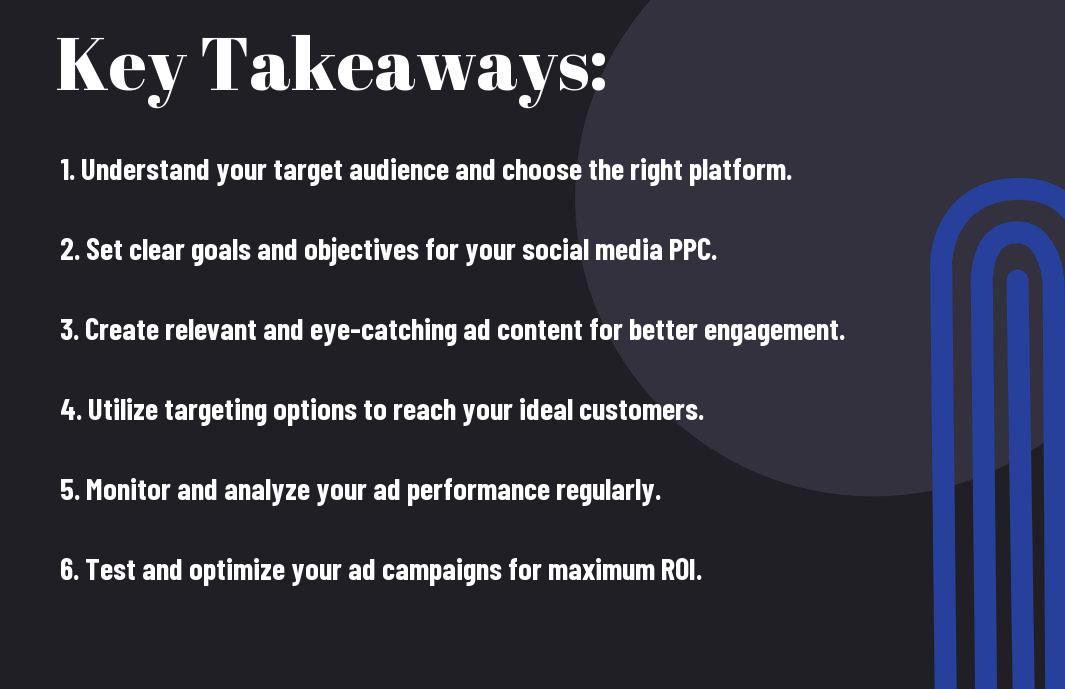Have you considered utilizing Social Media PPC to grow your business? In today’s competitive digital landscape, paid advertising on social media platforms has become an essential strategy for reaching your target audience and driving conversions. With the ability to specifically target users based on their demographics, interests, and online behaviors, social media PPC can provide a high return on investment for your business. This blog post will guide you through the process of leveraging social media PPC to enhance your brand’s visibility, increase website traffic, and ultimately boost sales. You will learn the key steps to create effective ad campaigns, optimize your budget, and maximize your ROI through strategic targeting and compelling ad content. If you are ready to take your marketing efforts to the next level, then read on to discover how to harness the power of social media PPC for your business.
Key Takeaways:
- Targeted Advertising: Social media PPC allows for precise targeting, enabling businesses to reach their ideal customers based on demographics, interests, and behaviors.
- Engagement and Brand Awareness: Utilizing social media PPC can enhance brand visibility and engagement, leading to increased awareness and recognition among the target audience.
- Cost-Effective Marketing: Social media PPC offers cost-effective advertising options, allowing businesses to set and control their budgets while reaching a larger audience compared to traditional marketing methods.
- Conversion Tracking: With social media PPC, it is possible to monitor and track the performance of ad campaigns, allowing for better understanding of the ROI and making necessary adjustments for improved results.
- Building Customer Relationships: Leveraging social media PPC for your business can facilitate direct communication with customers, helping build and maintain relationships, and nurturing customer loyalty.


Developing an Effective Social Media PPC Strategy
Some of the most successful advertising campaigns on social media platforms are driven by a well-crafted PPC strategy. If you’re looking to maximize the potential of social media PPC for your business, it’s crucial to develop a comprehensive strategy that aligns with your goals and targets the right audience. For a detailed guide on how to leverage social media for PPC success, check out How to Leverage Social Media for PPC Success.
Identifying Target Audience and Buyer Personas
When developing your social media PPC strategy, it’s essential to start by identifying your target audience and creating detailed buyer personas. This involves understanding the demographics, interests, and online behaviors of your potential customers. By doing so, you can tailor your ad content and targeting to resonate with the right audience and achieve higher conversion rates.
Setting Clear Objectives and Goals
Setting clear objectives and goals is a crucial step in creating an effective social media PPC strategy. Whether your aim is to boost brand awareness, drive website traffic, or generate leads, defining specific and measurable goals will guide your campaign and help you evaluate its success. By setting clear objectives, you can also allocate your budget more effectively and maximize the impact of your advertising efforts.
Platforms and Tools for Social Media PPC
Your success in leveraging social media PPC for your business depends greatly on the platforms and tools you use. It’s important to choose the right platforms and utilize the best tools to maximize the impact of your paid social media campaigns. In this chapter, we’ll explore the key social media platforms for PPC and the analytics and management tools that can help you achieve your advertising goals.
Overview of Key Social Media Platforms for PPC
When it comes to social media PPC, there are several key platforms that you can consider leveraging for advertising. Facebook remains a dominant force in the social media advertising world, offering a wide range of targeting options and ad formats. Instagram is also a popular choice for visual-oriented brands, with its seamless integration with Facebook’s ad platform. Twitter and LinkedIn are other platforms worth exploring, depending on your target audience and business objectives.
Utilizing Analytics and Management Tools
Monitoring the performance of your social media PPC campaigns is crucial for making informed decisions and optimizing your return on investment. Utilizing analytics tools such as Facebook Ads Manager, Twitter Analytics, and LinkedIn Campaign Manager can provide valuable insights into the effectiveness of your ads and audience engagement. Additionally, management tools like Hootsuite, Buffer, and Sprout Social can streamline the process of creating and scheduling your paid social media content, saving you time and effort.
Crafting Compelling PPC Campaigns
Keep in mind that perfecting your PPC campaigns on social media is not only about placing ads. It’s about crafting compelling ad content that will attract and engage your target audience. For a comprehensive guide on social media marketing for businesses, you can visit Social Media Marketing for Businesses.
Creating Engaging Ad Content
When it comes to creating compelling ad content for your social media PPC campaigns, you want to ensure your message is clear, concise, and captures the attention of your audience. Use strong and compelling language that will resonate with your potential customers. You want to highlight the most important and positive details about your product or service to entice them to click on your ad.
A/B Testing and Campaign Optimization
Once you have crafted your ad content, it’s important to continually A/B test different elements of your campaigns to optimize their performance. This could include testing different ad copy, images, targeting options, and more. By continually testing and optimizing your campaigns, you can ensure that you are maximizing your return on investment and reaching the most relevant audience for your business.
Measuring and Analyzing PPC Campaign Performance
Not every PPC campaign will be an immediate success. That’s why it’s crucial to measure and analyze the performance of your social media PPC campaigns regularly. This will help you understand what’s working and what’s not, so you can make informed decisions about where to focus your efforts. In fact, according to 11 Ways To Leverage Social Media To Grow Your Business, measuring PPC campaign performance is key to optimizing your social media strategy.
Key Performance Indicators (KPIs) to Track
When it comes to measuring the performance of your social media PPC campaigns, there are several key performance indicators (KPIs) that you should track. These include metrics such as click-through rate (CTR), conversion rate, cost-per-click (CPC), and return on ad spend (ROAS). By monitoring these KPIs, you can gain valuable insights into the effectiveness of your campaigns and identify areas for improvement. For example, if you notice a low CTR, it may indicate that your ad creative or targeting needs to be refined.
Adjusting Strategies Based on Data Insights
Once you have collected and analyzed the data from your PPC campaigns, it’s time to use these insights to adjust your strategies. For example, if you find that certain ad sets are not performing as well as others, you can reallocate your budget to focus on the top-performing ads. By leveraging the data to make informed decisions, you can optimize your social media PPC campaigns for better results. This iterative approach allows you to continuously improve the performance of your campaigns over time.
Conclusion
Taking this into account, it is clear that leveraging social media PPC can greatly benefit your business. By targeting specific demographics, utilizing A/B testing, and tracking metrics, you can optimize your ad campaigns to reach a wider audience and maximize your ROI. Additionally, with the ability to engage directly with your audience and create visually appealing ad creatives, social media PPC offers a unique opportunity to showcase your brand and attract new customers. By implementing these strategies, you can effectively harness the power of social media PPC to drive growth and success for your business.
FAQ
Q: What is Social Media PPC and how can it benefit my business?
A: Social Media PPC (Pay-Per-Click) is a form of online advertising where advertisers pay a fee each time their ad is clicked. It can benefit your business by allowing you to target specific demographics, increase brand awareness, drive website traffic, and generate leads and sales.
Q: Which social media platforms offer PPC advertising?
A: The major social media platforms that offer PPC advertising include Facebook, Instagram, Twitter, LinkedIn, and Pinterest. Each platform has its own unique strengths and audience demographics, so it’s important to choose the right platform for your business goals and target audience.
Q: How can I leverage Social Media PPC for lead generation?
A: To leverage Social Media PPC for lead generation, you can create targeted ad campaigns with compelling visuals and persuasive copy, use lead generation forms to capture contact information, and offer valuable incentives such as free resources or discounts to encourage sign-ups. It’s also important to have a well-designed landing page that aligns with your ad to maximize conversions.
Q: What metrics should I track to measure the success of my Social Media PPC campaigns?
A: Some key metrics to track for Social Media PPC campaigns include click-through rate (CTR), cost per click (CPC), conversion rate, cost per lead, return on ad spend (ROAS), and overall return on investment (ROI). By analyzing these metrics, you can make data-driven decisions to optimize your campaigns for better results.
Q: How can I optimize my Social Media PPC campaigns for better results?
A: To optimize your Social Media PPC campaigns, you can conduct A/B testing of ad creatives, targeting options, and ad copy to identify which elements perform best. It’s also important to continuously refine your audience targeting based on user behavior and engagement data, as well as to stay updated with the latest trends and features offered by each platform. Additionally, refining your landing pages and implementing retargeting strategies can further improve campaign performance.
